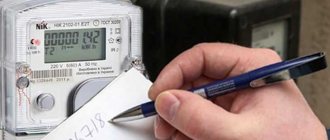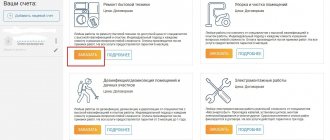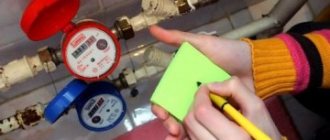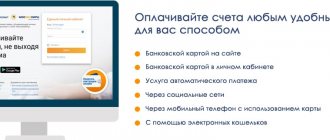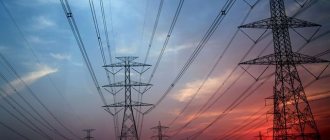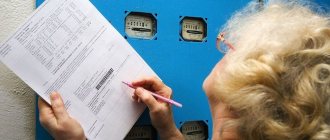According to accepted world practice, electricity consumers must install devices that take into account its consumption and pay according to their readings. In the Russian Federation, this requirement is enshrined at the legislative level. Taking readings and calculating payment based on them is the responsibility of the consumer (owner of the device). But if, as a rule, there were no problems with induction electricity meters, then with the advent of electronic devices, many consumers have questions about taking readings. The answers to them can be found in this publication.
Induction meters
This process for old-style devices is quite simple; it is enough to rewrite the information from the mechanical indicator, where the numbers display the total amount of electricity consumption over the entire period of operation of the device. After this, the readings for the previous period are subtracted from the resulting number. The result is multiplied by the current tariff.
The information is included in the payment receipt. Once every six months, energy companies have the right to monitor the metering device, which obliges the consumer to provide access to it.
Induction meter readings with drum
In the figure above, the segments of the mechanical indicator that display an integer are marked in red, and tenths of kilowatt-hours are marked in blue. There are models without displaying the fractional part. The meter's rated current, voltage, and frequency parameters are shown below. By the rotation speed of the drum, you can visually assess the current load power.
Important! Tenths are not included in the receipt.
Induction devices are gradually being replaced by electronic ones due to their undoubted advantages. Let's tell you what they are.
Types of meters and how they work
In order to correctly take readings from electricity meters and understand what to pay attention to, the consumer should check the type of device installed. Also look in the product passport to see how many values the number series has, and what numbers to write when taking readings.
Instruments for measuring electricity consumption exist for direct (used, for example, in electric vehicles) and alternating current used in everyday life. Devices can be induction or electronic. Full accounting of electrical energy is carried out by both types. The only requirement for induction devices is the corresponding accuracy class (degree of error).
Old household electricity meters (with an accuracy class below 2.0) are not designed for the use of energy-intensive household appliances (air conditioners, microwave ovens, water heaters, heated floors and others). They operate under significant overloads, which can cause a fire. A campaign is currently underway to replace outdated devices with modern ones, based on the Decree of the Government of the Russian Federation No. 354.
The operating principle of induction metering devices is based on the action of a magnetic field, which is formed in two current-carrying coils (voltage and current). Under its action, a movable conductor - a disk - begins to rotate, activating a device for measuring the number of kilowatt hours consumed. As the load increases, the number of revolutions increases, and the counting mechanism records the increase in flow rate. Induction models are easy to use and durable.
Electronic devices are a modern type of meters. Their work is based on the influence of alternating current on solid-state elements that generate pulses, the number of which is proportional to the consumption of electricity. The measurement result is displayed on the electronic display.
These models have a number of advantages:
- convenience when taking readings;
- they can be used for multi-tariff accounting;
- modern design;
- there is a self-correction function;
- have antimagnetic properties.
Compared to induction electricity meters, these models are more expensive, but their use provides savings due to the difference in tariffs. To distribute loads, electrical services use day and night metering. Modern household appliances are produced with a timer function, so some equipment can be loaded at night when the price is cheaper. If devices do not have standby modes, then you can install special sockets with a similar option.
Manufacturers have developed all kinds of automatic reading devices. When installing such a system, there is no need to transmit electricity meter readings. The data itself flows into the power grid. If you connect a bank card, payment will also be made automatically. The practice of using such accounting methods has already been described.
Operating principle of the induction model
The induction model includes two electromagnets, which represent the measuring mechanism of the device. They are located at right angles to each other. An aluminum disk is placed in their magnetic field. The device is connected in series with the electrical receiver of the current winding, and in parallel with the electrical receiver of the voltage.
Induction model device
The alternating current supplied to the windings of the core provokes the emergence of magnetic fluxes of variable magnitude, which induce eddy currents in the aluminum disk. They cause the disk to rotate, connected to a counting mechanism that takes into account the rotational speed of the disk.
The numbers on the counting mechanism allow you to record energy consumption. The greater the load, the faster the disk rotates and the greater the consumption. Three-phase devices have a similar operating principle.
Operating principle of the electronic model
The microcontrollers included in modern electronic models make it possible to increase the accuracy of measurements, and the absence of mechanics improves their reliability. Their design presupposes the presence of a special element base and information processing methods. Digital data processing has made it possible to account for active and reactive power, which is important when accounting for consumed energy in a three-phase network.
Multi-tariff electricity meters allow you to take into account the accumulated energy for a certain time of day. They are able to automatically determine the tariff being used. When figuring out how to count electricity using a meter, you should definitely remember this.
During operation, the converter receives data from a current and voltage sensor. The converter transmits the encoded information to the display, where it is displayed in a form that is relevant to the user.
The user sees the data in electronic form
Advantages of new electronic metering devices
The first glance at the front panel of an electronic device can cause some confusion. Instead of the usual mechanical indicator, there is a digital display and some strange buttons.
Electronic meter front panel
In fact, there is nothing complicated; below we will describe in detail how to take readings from various electronic models. As for their advantages, these include:
- Indication of the current date and time.
- Saving readings for the previous month in the device memory.
- Transferring data with readings to the control center of the energy company providing the services.
- Possibilities of multi-mode tariffing.
- The current sensor can be a shunt, a current transformer, or both.
It makes sense to consider the last point in more detail.
Automatic data transfer
Recently, thanks to the widely developed information network, which operates quite quickly with huge volumes of data, as well as the ability to organize separate communication channels, electronic electricity consumption meters with automatic data transmission have appeared. The only problem is the complexity of installation and configuration, but subscribers do not have to participate in the process of collecting and transmitting data.
Taking CE303 meter readings using the iRZ MC52i-485GI GSM modem (video instructions)
What is multi-tariff mode and its purpose?
As you know, the load on the energy system is uneven. During the day, electricity consumption is several times higher than at night (to be precise, the peak occurs in the morning and evening). In order to motivate the population, multi-tariff systems have been introduced in many countries, including Russia, taking into account the characteristics of a particular city (settlement).
The most common is the two-tariff system (day-night), and its three-tariff modification (peak-half-peak-night) is also found. The transition to such metering schemes can significantly reduce electricity costs. As an example, we give the prices for various time zones for the city of St. Petersburg (for an apartment with a gas stove).
Example: tariff table for St. Petersburg.
| Tariff name | Cost, rub) | |
| Single | 4,32 | |
| Dual zone | day – T1 (7:00-23:00) | 4,55 |
| night – T2 (23:00-7:00) | 2,62 | |
| Three-zone | peak – T1 (7:00-10:00 and 17:00-21:00) | 4,58 |
| half peak - T2 (10:00-17:00 and 21:00-23:00) | 4,32 | |
| night – T3 (23:00-7:00) | 2,62 | |
As you can see, the difference in price between night and day rates is slightly less than twofold. Even if you only turn on the washing machine when the nightly tariff is in effect, you can save a lot.
To switch to a two or three tariff system, it is necessary to install an electronic electricity meter, the design of which allows for such a count. As for induction modifications, they do not have such functionality.
Features of determining network power
In general, the electrical network is designed so that its operation does not require special knowledge. It is enough to follow some rules, the main one of which is to prevent overload.
You may be interested in Features of resonance in an electrical circuit
Important! Failure to comply with the rules for using the electrical network can lead to failure and even fire.
It is important to note that the technical characteristics of the outlet and the household appliance differ from each other:
- In sockets, the maximum permissible alternating current is measured in Amperes: in the old housing stock of Russia it is 6 A, in Europe - 10 or 16 A;
- The power of connected devices is measured in Watts.
Information on an electrical appliance can be marked in different ways.
How to calculate the power of electricity? To calculate, you will need a formula:
P = U*I, where:
P - power,
U - voltage in Volts,
I is the current strength in Amperes.
The voltage of a working outlet is 220-230 Volts; the current can be measured with a multimeter.
To determine the current in the outlet, you should use a multimeter.
How to take electricity meter readings day-night?
Due to the large assortment of electronic models, it is not possible to give a single algorithm of actions. Detailed instructions are given in the technical documentation that comes with each device. Later in the article we will describe in detail the process for the most common models, but for now we will talk about the general principle of calculations using a two-tariff system.
All electronic meters have a built-in clock, which allows you to record electricity consumption for different time zones. In two-tariff models there are two of them - T1 (day) and T2 (night), their validity periods were given in the table above. A separate count is kept for each period. At the same time, the device stores the readings of the previous reporting period in memory, which is quite convenient for calculations. The easiest way to explain the process is with an example.
Let’s say we need to take readings on October 20, for the current date they are as follows:
- For tariff T1 – 2052.95 kWh.
- T2 – 1024.16.
- Total – 3077.11.
We rewrite this data into a receipt and call up information for the previous reporting period (September 20), let’s say we display:
- T1 – 1892.81.
- T2 – 926.1.
- Total – 2818.91.
We calculate the difference and then write down the result:
- T1 – 160.14.
- T2 – 98.06.
- Total – 258.2.
We enter this information on the receipt. Next, we calculate the payment by multiplying by their cost in accordance with current tariffs. For example, according to the information in the table above, for St. Petersburg these calculations will be as follows:
T1 - 160.14 x 4.55 = 728.67 rubles.
T2 – 98.06 x 2.62 = 256.92 rubles.
Total – 728.67 + 256.92 = 985.59 rubles.
https://www.youtube.com/watch?v=pW1977Cfpds
How is energy measured?
Translated from Greek, energy means activity, force, action. It is a scalar quantity and measures all kinds of motion and interconnections of matter. Energy is denoted by the letter E. The units of measurement for this quantity are: in the SI system - joule (J), in the GHS system - erg.
Electrical energy consumed by electrical appliances is calculated by meters. They provide numerical readings of power consumption (kW) per kWh.
The Relationship Between Strength and Energy
A connection has been established between the conservative force, which causes the potential energy of all interacting bodies, and this energy.
For your information. Conservative forces are those forces that do work to move a point. In this case, the work is determined by the extreme positions of this point: initial and final.
Conservative forces include the following forces:
- heaviness;
- elasticity;
- Coulomb forces.
If you close the trajectory of a point under the action of conservative forces, it will be equal to zero.
You can trace the connection using the following algorithm:
- When at any point in space a body is subject to the action of a conservative force, it means that it is located in a potential field.
- A change in the position of a body within a field causes a change in potential energy, in which a conservative force does work.
This work can be expressed mathematically. For example, the body moved in a random direction r, deviating from the initial position by a very small distance dr. This means that dA = F*dr*cosα = Fr, dr, where F = F* cosα is the projection of the force onto the direction r.
There is an equality: dA = – dEп, where Ep is potential energy. So, putting an equal sign between the two expressions, it turns out:
Fr *dr = – dEп, from which Fr = – dEп/dr is expressed.
The ratio dEп/dr is a quantity showing the rate of change of potential energy along a given direction; it is the derivative of Ep in the r direction.
Attention! The minus sign means a decrease in potential energy in the direction dr. The partial derivative symbol indicates that the differentiation of the potential energy Ep (x, y, z) occurs only with the argument x, with the other two unchanged.
Power and energy
Power P is the work done per unit of time. The unit of power is watt (W). To find out how many watts are 1 kW, you need to remember that “kilo” is 103. Therefore, 1 kW = 103 W, and 10 kW = 104 W.
Typically, the power of electrical receivers is measured in kilowatts. Applicable to technology, there is also a measurement of power in horsepower (hp). One such horsepower is equal to 736 watts.
Power and horsepower
The ability of a certain body or an entire system to perform work is characterized by its energy. Energy unites in its concept all events in nature. Different types of movement are characterized by different types of energy.
Advice. Mechanical energy related to the movement of a body is called kinetic, associated with the mutual position of bodies (body parts) of the system - potential.
Calories and joules
Before you figure out how to convert (convert) calories to joules and vice versa, you need to know what these two concepts mean.
The joule is a unit used to measure work, energy, or heat. In the international SI system, the joule is denoted by J (J). The work done by a force of one newton (1N) to move a point in the direction of application of the force one meter (1m) is equal to one joule (1 J).
Calorie is a quantity not separately reflected in measurement systems, used to determine the amount of heat. To heat 1 g of water by 1 C0, you need to spend energy equal to 1 calorie (cal). In this case, 1 cal = 4.1868 J.
Communication with other units
You can use an online calculator to express calories in joules and back.
The program interface allows you to enter the values of the required quantities (using abbreviations of multiple values). When you don’t have the Internet at hand, it’s easy to make a translation by making a proportion. For example, you need to find out how many kilocalories are in 100 kJ. To do this, make up the proportion:
- 1 kcal = 4.1868 kJ;
- X = 100 kJ.
Solving the proportion, we get the expression X = 100 * 1/4.1868 = 23.9 kCal. The answer is that 100 kJ contains 23.9 kcal.
How to take readings from electricity meters Mercury 200, 206, 233, 230, 231, 234
The listed models have a similar interface. Control is carried out using two buttons (see Fig. 3). One, with the inscription “ENTER”, is used to select indications of various tariffs, the second, which shows a ring with an arrow pointer, is used to select a mode.
Front panel of three-phase meter Mercury 230
The procedure for taking readings is as follows:
- It is necessary to set the appropriate mode, in this case “A”. To switch modes, you need to briefly press the button with the ring until a dash appears under the corresponding letter on the display (marked in red in Fig. 3).
- After setting the “A” mode, the display will show the readings for the T1 tariff; to view the data for other tariffs (T2 and T3), you must briefly press the “ENTER” button. The number of tariffs is determined by the meter settings; they are made by employees of the energy company.
- Information is displayed in the following format:
- Tariff name (T1-T3).
- Actually, the readings (a number with two decimal places).
Please note that these devices have special software. Thanks to it, you can get more detailed information when connecting the meter to a PC.
Universal configurator for the Mercury line of meters
How to take readings from the electricity meter Energomer CE 101, CE 102, TsE6803V?
For electronic devices of Energomer models, the procedure for obtaining readings is quite simple and does not require any pressing of control keys; in fact, on some modifications they are absent altogether.
Front panel of meter CE 102
Every 10-15 seconds, the display cyclically displays the data of time zones from T1-T2 or T1-T3 (depending on the modification of the device) and their total value. In this case, the name of the tariff (T1-T3 and T - the total amount) and, in fact, the readings in the form of a number with two decimal places are displayed at the top of the screen.
Front panel of meter TsE6803V housing type P32 (for DIN rail)
It is not possible to view readings for the previous period.
How is power consumption measured?
The amount of current spent is measured in Watts (W) or Volt-Amperes (VA). Measurement in Volt-Amps is often found among foreign manufacturers, and in Watts - among Russian ones.
Important! Often they indicate not Watts (W) or Volt-Amps (VA), but kiloWatts (kW) and kiloVolt-Amperes (kVA) - a thousand Watts and a thousand Volt-Amps.
Many people believe that W and VA are equal quantities, but this is not so. Active power is measured in Watts (the amount of energy consumed, denoted by the letter “P”), in Volt-Amps - total power (the sum of active and passive powers, denoted by “S”). That is, these quantities are not equal; it is impossible to equate Watts to Volt-Amperes.
The required values can be indicated directly on the equipment
To translate you need to use the formula:
P = S*power factor.
If the coefficient is unknown, it is taken as 0.8 (0.8-0.95 is a good value, 0.65-0.8 is satisfactory).
You can also use online calculators when calculating. If using the formula does not work, you can approximately equate: 1 kVA = 0.7 kW.
How to take readings from a Micron electricity meter?
This procedure is also not difficult. Using the button (marked in red in Fig. 7), the appropriate information display mode is selected.
Micron Counter
On the case, below the information board, the names of the modes are printed; a “bird” is depicted on the screen above the current one. To take readings correctly, you need to use the button to set the T1-T3 mode. For example, if the mark is above T2, then the displayed data will correspond to the indicators of the selected tariff.
We hope that the information provided will help those who do not know how to take meter readings.



